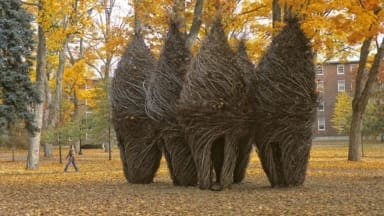
“Every ‘Stickwork’ project begins with the dicey hunt for a motherload of flexible saplings. These sticks need to have good colour, an overall uniformity, and fall within a few certain species”, explain Patrick Dougherty.
Born in Oklahoma in 1945, Dougherty earned a B.A. in English from the University of North Carolina in 1967 and an M.A. in Hospital and Health Administration from the University of Iowa in 1969. Fuelled by his artistic genes, he returned to the University of North Carolina to study art history and sculpture. Armed with his creative degree, carpentry skills and love of nature, Dougherty who is intrigued by primitive building techniques, began experimenting with tree saplings as a construction material. The founder of Stickwork, Dougherty has been making these monumental works of art for the past 35 years, and to date, has built around 300.
Dougherty has an uncanny ability to weave, twist and blend his array of sticks into enchantingly magical, yet contemporary forms that sit beautifully in their chosen environment. Each piece unique, he manages to fully optimises the beauty and potential of the material, which is cunningly woven and twirled to create sophisticated, soft movement and flow throughout the monumental pieces.
According to the artist, his method of construction is a layering process, whereby each ‘coat’ of branches adds to the strength of the final work. “There is a structural phase which underpins the overall shapes and consists of large saplings stuck upright into the ground and intwined with a random structural weave of smaller material. This is followed by the aesthetic phase, which is akin to using sticks as lines with which to draw and which appliqués a luxurious finish on the surface. The final phase is cosmetic and attempts to polish the surface by using smaller saplings to cover all the unsightly areas”, explains the artist.


Only the best artists, truly know and respect their medium of choice. An avid gardener and tree lover, Dougherty has a deep admiration for the source of his material, so evident in all his works. “In North Carolina, where I live, my favourite trees include ash, dogwood, willow, sweet gum, and maples of all varieties, but particularly, red maple which holds its colour and sports an amazing basket of branches. In the Midwest, I prefer the robust rough-leaf dogwood which invades farm fields in Kansas and the dense thickets of Chinese elm found along waterways in other parts of that region. In Washington State, Oregon, and all places Northwest, willow grows in profusion and vine maple, as the name suggests, produces a bounty of long slender branches. In California and throughout the arid West, willow thrives along every waterway and can provide a natural warehouse of limber material, some with colorful names like convent willow, cowboy willow, or Apache willow. In Hawaii, a grove of Java Plum or Strawberry Guava can really come in handy”, says Dougherty.
His works grace the grounds of fortunate museums, universities and (botanical) gardens around the world. “I love my work as a sculptor”, explains the artist. It has meant extensive travel and spending most of my life outside. It has given me access to many treelined places around the globe and high adventure in searching for the perfect sapling. I have built a sculpture in the branches of a sacred tree in Rinjyo-in Temple in Chiba, Japan, and have used a tree in Dublin to support the makings of a ‘copycat’ round tower in the side yard of the Tallaght Community Art Center. I have conjured a group of stick pyramids in the sculpture garden at the Montgomery Museum of Fine Art, Montgomery, Alabama, and have graced the Betty Ford Alpine Gardens in Vail, Colorado with flight of twenty-foot tall Japanese-style jars”. he explained.
Scales vary, but the works take Dougherty (with several assistants and a cadre of volunteers), working eight hours a day, approximately three weeks to complete, with a “constant supply of saplings to keep the build on track”. A detailed operation, Dougherty organises the saplings in different lengths, “some larger structural pieces, some very long thin saplings, and more than half the material needs to be small, less than five feet long and 3⁄4 inch”.
When working in other parts of the world, the search for the sheer volume of saplings needed, has according to Dougherty, “the edge of real adventure”. He explained, “when our fieldwork in Melbourne, Australia failed to find a local gathering site, the sponsor turned up a willow farm that grew cricket willow for manufacturing of cricket bats. In Sweden, a specialty farm grew willow for snow markers placed along winter roads. In Korea, the sponsor located a nearby town in the process of trimming all the municipal tree cover; a group of farmers with trailers followed and bundled the branches as they fell. At Chaumont Sculpture Park in France’s Loire Valley, saplings arrived daily by farm tractor from the riverbank below the park’s castle. When working at Ness Gardens on the Wirral, I was dizzied by the offer to experiment with any of the hundreds of varieties in the British national willow collection which is maintained there”.
Completely organic, Dougherty’s artistry is designed not to last, which allows for artistic freedom and keeps his artistry fresh and contemporary. “Like the saplings they are made of my sculptures have a limited lifespan of two good years and counting. As of today, I’ve created 333 of these large temporary sculptures with 25-30 standing in good condition at any one time. I have no regrets about their temporality and am fond of pointing out that ‘every good flowerbed has its day’. I always look forward to new possibilities with hopes of using that perfect grove of saplings”, explains Dougherty.
